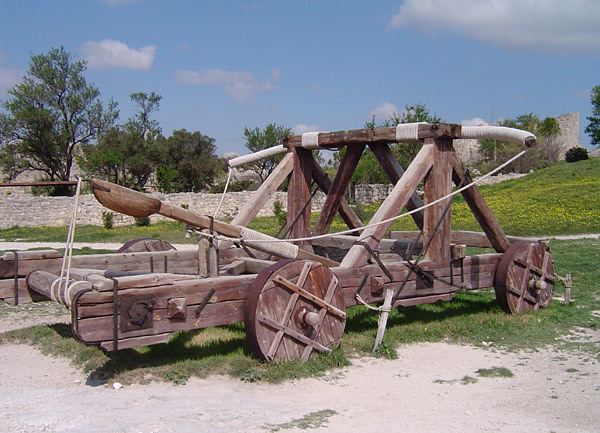 | ||
Petraria Arcatinus is a possibly fictitious catapult which is claimed to have been in use during the Middle Ages. The name appears in some non-scholarly modern texts and websites. It is often roughly translated as "bow-powered stone-thrower". Modern depictions of this catapult are usually of an onager with its torsion spring power source replaced by a bow, but some doubt if this weapon ever existed.
Contents
History
The term "petraria" appears throughout the Medieval historical record, and is used refer to some types of catapults. It is unclear if "petraria arcatinus" appears anywhere in Medieval texts, or if its usage is more modern. According to some on-line sources, one of these catapults may have been used during the twelfth century at the Siege of Acre in the Third Crusade, where King Philip of France had named one of his catapults "Malvoisin" (French for "Bad Neighbor"). However other sources say this machine was a trebuchet. (Some confusion may spring from the fact that the name 'Malvoisin' was used more than once, having later been the name of a trebuchet in the First Barons' War at the Siege of Dover, and similarly at the Siege of Minerve in 1210, and possibly for other machines of war.)
Similar Weapons
In Roman times, there were bow-powered stone-throwers in use, however these are assumed to be in the form of a large gastraphetes or bow-powered ballista. The term "petraria" didn't come into use until much later. There is also a counterweight trebuchet which includes a mechanism to simultaneously span a large crossbow, allowing a single operator to use the same winch to prepare two weapons at a time.
Reconstructions and Depictions
There are no known artifacts of this weapon in existence. There are also no verified drawings or descriptions from a reliable source in that time period. Most modern replicas are not functional. There have been attempts to build a working Petraria Arcatinus based on the onager/bow combination, including a small retail kit, and a larger catapult built for a contest. Both of these designs feature a large steel bow set at a sloping angle, and pulling the catapult arm approximately in the middle or lower. In contrast, many replicas that do not appear to function use a smaller bow, often wooden, and positioned horizontally, with a bowstring attached near the end of the arm. The retail kit manufacturer notes that initial attempts to mimic existing replicas did not yield an effective catapult.
The Ancient Greek and Roman ballistae were often used for stone projectiles, and this suggests a simpler design in which a bow might push the stone directly, without the use of a throwing arm. The origins of the onager/bow combination design are unclear, but here are some examples found in the modern world:
